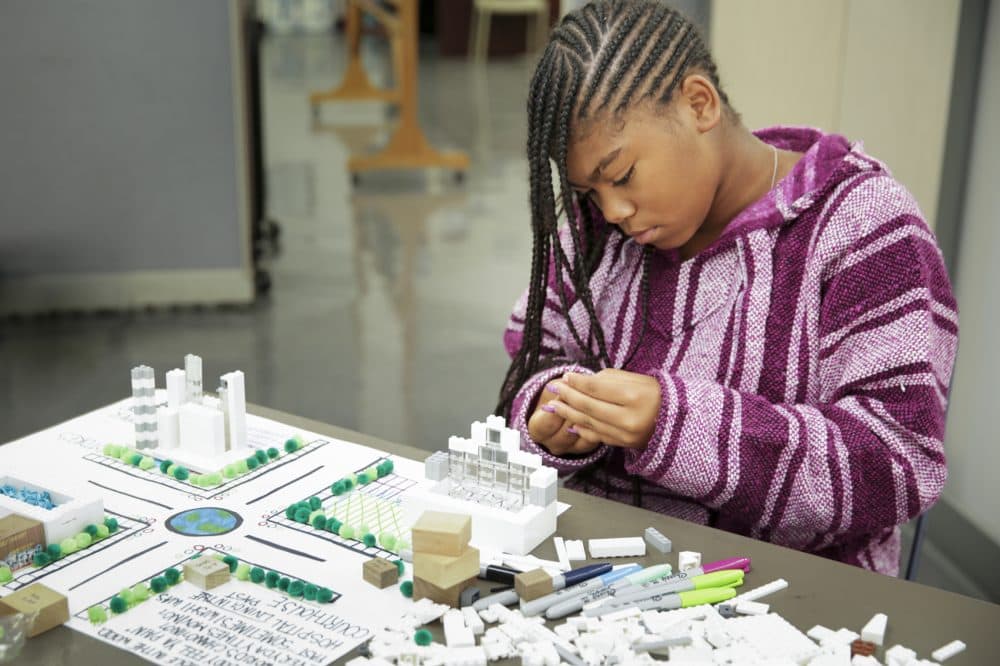Advertisement
Can Hip-Hop Inspire A New Generation Of Architects?

Michael Ford has two passions: hip-hop music and architecture. In fact, his master's thesis at the University of Detroit was titled "Cultural Innovation: Hip Hop Inspired Architecture."
Ford, an architect, designer and founder of BrandNu Design, has partnered with software design company Autodesk to start free architecture camps around the country that teach disadvantaged kids about design and urban planning — all through the lens of hip-hop. The camps also feature hip-hop stars, including singer and lyricist Nikki Jean (@nikkijean).
Jean and Ford (@HipHopArch) join Here & Now's Robin Young to talk about the camps and what they hope to achieve. Ford says he was inspired to start the camps when he had a lightbulb moment in a planning meeting for the city of Madison, Wisconsin.
“I noticed in that room there was a lack of diversity and youth,” he says. “And right there I realized that if we are talking about 20 years into the future, we should have youth involved in this planning initiative who will be living in their prime, 20 years from now.”
Interview Highlights
On how the hip-hop architecture camps work
Michael Ford: “It's a one-week intensive that challenges youth to explore architecture and the implications of architecture using rap lyrics as a way to diagnose some of the failures of architecture in black and brown communities across the country. We then challenge the youth to conceive and generate new architecture, once again, that's based on some of those same rap lyrics.”
On some of the rap lyrics that inspire the work
MF: “I think one of the best examples might come from Grandmaster Flash and the Furious Five, their song, 'The Message.' That starts off with a critique of architecture.
“I oftentimes describe rap music as the post-occupancy evaluation of modernism … saying that once we design and construct a space, we oftentimes go back and see how successful that architecture may have been, and that evaluation allows us to design the next space even better. That hasn't happened with public housing, or it's happening on a very small scale. So I look at rap music as that unsolicited evaluation of architecture. So Grandmaster Flash and the Furious Five in the first line, 'broken glass everywhere,’ he's talking about the environment that they're living in, which is totally different from the urban renewal that a lot of planners and architects thought they were bringing to cities of color. Other lyrics like Snoop Dog, 'the grass ain't green,' he's talking about the lack of trees.
Advertisement
“The overall plan for the housing projects was that this would be towers in a park. And what happened is that a lot of these towers existed in concrete jungles as opposed to the lush green environments that planners and architects thought they were creating.
“The Cross Bronx Expressway is a similar story to what has happened across the United States. It's a story that ultimately led to the creation of environments that necessitated the birth of hip-hop.”
"Rap has structure. The way you put together a song has a structure. And it's very easy to draw the parallel between the structure of a song and the structure of a building."
Nikki Jean
On what Nikki Jean sees in the kids who attend the camps
Nikki Jean: “The most beautiful thing to see is the ‘aha moment’ where they grasp the interconnectivity between something as intangible as the music they love and something as tangible as the places they live.
“Rap has structure. The way you put together a song has a structure. And it's very easy to draw the parallel between the structure of a song and the structure of a building. And one of the amazing things that I learned through working with Michael is that architects, they're like, ‘Oh, what does it make you feel like when you walk in this building?’ They're trying to get a utility, and also … that beauty from it as well. And that's what we're trying to do as artists. That's the joy and the connection for the kids, too. They're like, ‘Oh, I was already talking about this. I already knew about this. I just didn't, I didn't know that I knew.’ I think that one of the things that is so captivating to young people with hip-hop is there is a rhythm. There is a cadence to it. But being exposed to Michael and having the opportunity to see the rhythm and the cadence and architecture as well allows them to more easily read their environment as a text and feel it the way they feel music.”
On how kids create models of communities using rap lyrics
MF: “They literally create a community that the density and the scale is based on their favorite rapper. So when we talk about heights, they're not picking an arbitrary height, say I want a building that’s five stories or a building that’s 13 stories. If your favorite rapper is Lupe Fiasco, the density of your community, this height of your buildings, are going to be based on Lupe Fiasco rhyme schemes. So the communities that they create are based on something that they already love.
“What we do is we look at every single word and syllable, and we create a very abstract diagram that charts the rhyme scheme of Lupe Fiasco. Let's say it's ‘Hip-Hop Saved My Life.’ ... And that chart, that diagram, that piece of art eventually becomes the building. So if Lupe Fiasco has a rhyme with words that have multiple syllables, that building may be a lot taller than a rhyme scheme that uses words with a single syllable. … So we’re literally converting lyrics into architecture.”
This rap video is a final project by kids who participated in the Austin, Texas, Hip Hop Architecture Camp in 2017.
This segment aired on June 28, 2018.